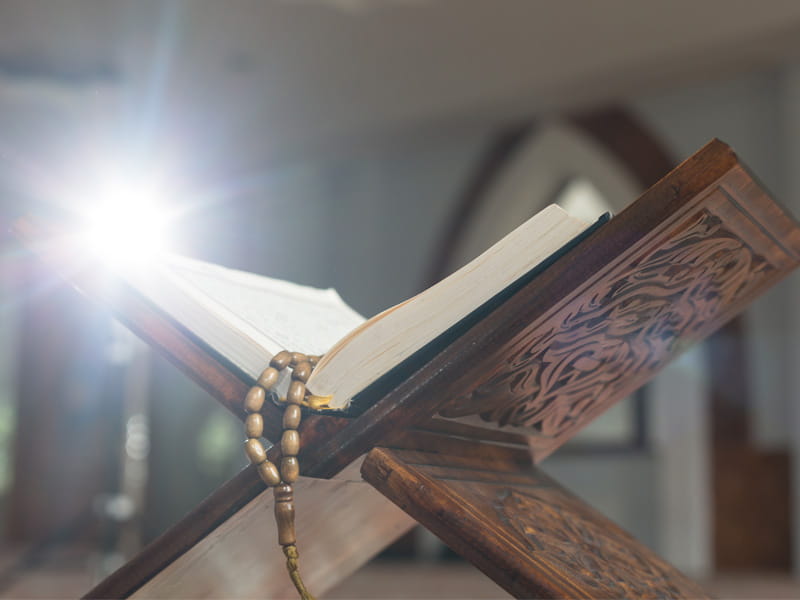So after consulting a Muslim teacher, the author used gold leaf to represent Muhammad's outline, creating a silhouette that is beautiful yet respectful of Muslim beliefs.
Global outrage and violence over insulting cartoons of Muhammad reveal just how inflammatory portrayals of the prophet can be. So to avoid controversy, visual artists like Demi have long found creative alternatives. The techniques range from blotting out Muhammad's face in medieval manuscripts to shooting contemporary films from his vantage point.
History proves, however, that passions can still erupt even when artists go to great lengths to avoid offending.
Nothing in the Qur’an forbids representations of Muhammad. But the Hadith, a collection of sayings and actions attributed to the prophet and his closest companions, explicitly condemns such depictions, as well as pictures in general. The problem is two-fold: fear that pictures could become objects of veneration, thus constituting idol worship and concern that creating images mimics an act of God.
The restriction gained fresh appeal during the Crusades, when Muslims wanted to differentiate themselves from Christians, and viewed depictions of Jesus as leading to idol worship. Over time, Muslims have come to take the prohibition more seriously, pushing today's artists to find visual alternatives.
"Not only has it become very solidified and strengthened, it really has become an article of faith," said Khaled Abou El Fadl, an Islamic legal scholar at
Moustapha Akkad, a Syrian filmmaker and observant Muslim perhaps best known for producing the "Halloween" series of horror films, did not show Muhammad's face in "The Message," his 1976 film about the prophet. Instead, he shot the film from Muhammad's perspective, so at times it seems as if
characters are addressing the viewer.
Still, the film reaped denunciations and bomb threats while in the making, compelling Akkad--who was one of dozens killed in terror attacks in Amman, Jordan last November--to seek blessings for his project from scholars at Al-Azhar University in Cairo, as well as other religious institutions.
Nonetheless, the film's release provoked black Muslims from the heterodox Nation of Islam to take dozens of hostages in
Makers of the animated children's film "Muhammad: The Last Prophet," took a similar visual approach, also seeking approval from Al-Azhar. Of the 196,000 drawings done for the film, released in 2004, not one depicts Muhammad. Like "The Message," the animated film used music to help indicate Muhammad's entries and exits.
A more awkward attempt to respect the tradition is at the U.S. Supreme Court, where Muhammad appears between the emperors Justinian and Charlemagne on a marble frieze, done in the 1930s, depicting 18 historical legal figures. When the image came to the attention of the Council on American Islamic Relations in 1997, the Washington-based advocacy group asked the court to remove it.
William Rehnquist, then chief justice, told CAIR in a letter that removing the image would damage the frieze and that
Attempts at respecting the restrictions while fulfilling artistic expression go back centuries, scholars say. Although some early Islamic jurists argued that there was no harm in painting pictures of Muhammad, so long as they were not degrading or in places of worship, others ruled that depictions were permissible only if his visage was blotted out. Thus, many depictions of Muhammad, with and without a face, exist from the first several centuries of Islam, especially from
These early depictions inspired Demi to create her image of Muhammad. But as a precaution, Demi's editors at Simon and Schuster requested a review from the Islamic Society of North America, which put her in touch with Afeefa Syeed, co-director of the
Syeed--who advises MTV, Nickelodeon and other media outlets on Muslim issues--advised against any direct depictions.
"My response was that for centuries now, children have been taught about the prophet, taught to love the prophet in so many ways without ever having seen a picture of him," Syeed said.
Besides, she said, early paintings of Muhammad should not be taken as precedent since those paintings were not for the masses, but rulers who were not always respectful of tradition and kept the paintings in the privacy of their own palaces.
After some "back and forth," Syeed said, the argument that ultimately persuaded Demi was that it would be a shame if such a well-intentioned attempt to explain Islam and Muhammad would get lost because of "something that would really hurt Muslims a lot."
The restriction on depictions is not only a point of respect, but a spiritual catalyst that allows Muslims to imagine Muhammad without being prejudiced by pictures, Syeed said. Indeed, stories about Muhammad have been passed down in books and among families and cultures for generations, based on the Hadith that contain physical descriptions of the prophet, Syeed said.
One of the more common descriptions based on the Hadith comes from "The Message of Mohammad" by Athar Husain.
"Muhammad was of a height a little above the average," Husain wrote. "He was of sturdy build with long muscular limbs and tapering fingers. The hair of his head was long and thick with some waves in them. His forehead was large and prominent, his eyelashes were long and thick, his nose was sloping, his mouth was somewhat large and his teeth were well set. His cheeks were spare and he had a pleasant smile."
Muslims generally don't feel like they are missing out by not having pictures of the prophet, said Amir Hussain, a theology professor at
It's like the book vs. the movie," Hussain said. "The movie is often disappointing while the book lets you use your imagination.

